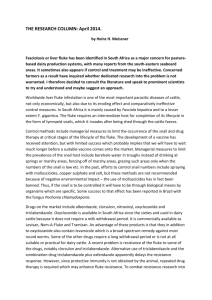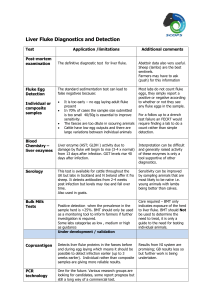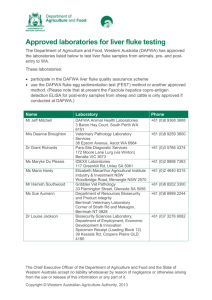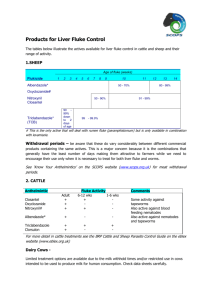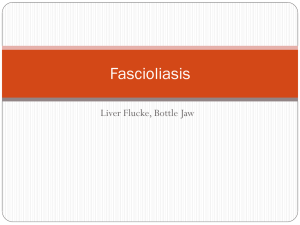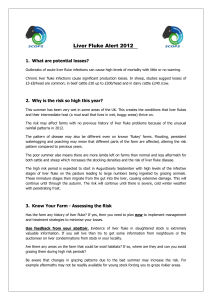Liver Fluke
advertisement
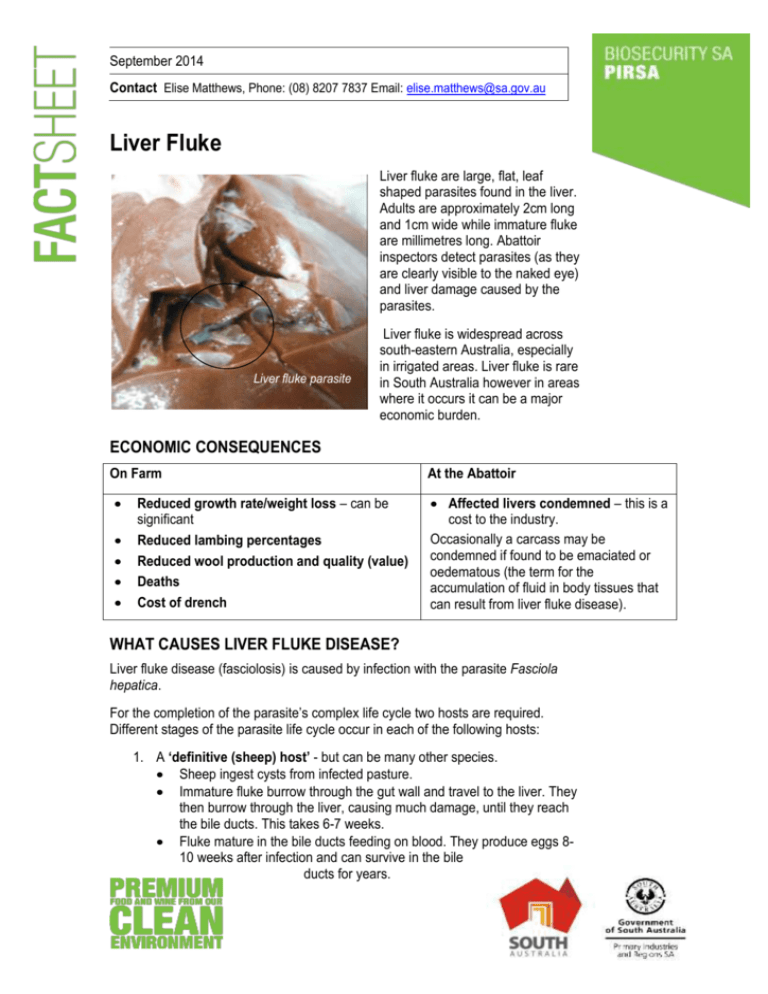
September 2014 Contact Elise Matthews, Phone: (08) 8207 7837 Email: elise.matthews@sa.gov.au Liver Fluke Liver fluke are large, flat, leaf shaped parasites found in the liver. Adults are approximately 2cm long and 1cm wide while immature fluke are millimetres long. Abattoir inspectors detect parasites (as they are clearly visible to the naked eye) and liver damage caused by the parasites. Liver fluke parasite Liver fluke is widespread across south-eastern Australia, especially in irrigated areas. Liver fluke is rare in South Australia however in areas where it occurs it can be a major economic burden. ECONOMIC CONSEQUENCES On Farm At the Abattoir Affected livers condemned – this is a cost to the industry. Occasionally a carcass may be condemned if found to be emaciated or oedematous (the term for the accumulation of fluid in body tissues that can result from liver fluke disease). Reduced growth rate/weight loss – can be significant Reduced lambing percentages Reduced wool production and quality (value) Deaths Cost of drench WHAT CAUSES LIVER FLUKE DISEASE? Liver fluke disease (fasciolosis) is caused by infection with the parasite Fasciola hepatica. For the completion of the parasite’s complex life cycle two hosts are required. Different stages of the parasite life cycle occur in each of the following hosts: 1. A ‘definitive (sheep) host’ - but can be many other species. Sheep ingest cysts from infected pasture. Immature fluke burrow through the gut wall and travel to the liver. They then burrow through the liver, causing much damage, until they reach the bile ducts. This takes 6-7 weeks. Fluke mature in the bile ducts feeding on blood. They produce eggs 810 weeks after infection and can survive in the bile ducts for years. Eggs pass back to the intestines and pass onto pasture in faeces. 2. An ‘intermediate (snail) host’ - the indigenous fresh water snail found in swamps, drains, irrigated pastures etc. Under suitable wet conditions larvae hatch from fluke eggs. Larvae must invade a snail in order to develop; development takes 2-3 months. Advanced larvae pass from the snail and form cysts on pasture. Image adapted from Wormboss (www.wormboss.com.au) WHAT MIGHT BE SEEN ON FARM? There are three disease syndromes, with variable symptoms, associated with liver fluke disease (fasciolosis). 1. Acute (sudden) disease – can occur as an outbreak due to the short term ingestion of very large numbers of fluke cysts. This causes significant liver damage: Ill thrift and anaemia. Sudden weakness and death due to sudden blood loss. Jaundice (yellow tinge to the tissues usually noticed as yellow gums and whites of the eyes). Abdominal pain and reluctance to move. Some animals suffering acute disease may show no obvious symptoms. 2. Chronic (slow onset) disease – due to the accumulation of adult fluke within bile ducts. The signs develop slowly: Pale gums and weakness due to anaemia. Bottle jaw (swellings below the jaw) and pot bellies. Ill thrift and weight loss. 3. Black disease – is a clostridial (bacterial) disease usually triggered by liver fluke. Migrating immature fluke cause liver damage that stimulates the activation of Clostridium novyi spores in unvaccinated or incompletely vaccinated sheep. Sudden death – these clostridial spores produce a lethal toxin hence the disease is highly fatal. 5 mm TREATMENT Drenching should be strategic and based on the level of infection present and seasonal conditions. Often three drenches are given: 1. Late autumn 2. Late winter/ early spring; and 3. Mid summer. Because most infections are picked up over summer and early autumn the late autumn drench is the most important. Drenches containing triclabendazole, a drug which targets both mature and immature fluke, is recommended for this drench. However resistance has been documented and drench groups should be rotated for other treatments. Consult your local veterinarian or animal health specialist for further advice and a drench plan for your property. PREVENTION 1. Good Biosecurity - stock introductions Avoid introducing sheep onto your property infected with fluke. Quarantine and drench all sheep that come from a liver fluke area. 2. Monitor fluke status By using fluke faecal egg counts (or blood tests for early infections), abattoir surveillance reports and post-mortem findings. 3. Snail habitat control Minimise snail habitat by improving drainage where possible (laser-levelled land is less at risk compared with areas where water can sit). Alternatively convert areas to deeper quicker moving water and keep drains clean so water can flow freely. Fix broken pipes/leaking troughs to stop permanent wet areas. 4. Grazing management Fence off swampy areas to stop sheep access. Provide clean trough water as an alternative to drinking from swamps, drains etc. If infested paddocks must be used, graze clean sheep over infected areas and move to a snail-free paddock after 8-10 weeks and drench. This prevents fluke eggs from reaching the snails and continuing their life cycle. 5. Vaccination to prevent Black Disease Ensure stock are fully vaccinated, including correct timing of boosters, against Black Disease. Commercial 5-in1 and 6-in-1 vaccines cover Black Disease. FOR FURTHER INFORMATION: Contact the Enhanced Abattoir Surveillance (EAS) Program manager Dr Elise Matthews, your local veterinary practitioner, livestock consultant or local PIRSA Animal Health Officer. FOR ANY SIGNS OF UNUSUAL OR SERIOUS ANIMAL DISEASE, PLEASE CALL THE 24/7 DISEASE WATCH HOTLINE: 1800 675 888
